Building Information Modelling: Stages, Scope, and Issues
VerifiedAdded on 2021/06/14
|9
|1795
|239
Report
AI Summary
This report provides a comprehensive overview of Building Information Modelling (BIM), a technology revolutionizing the Architecture, Engineering, and Construction (AEC) industry. It begins by introducing BIM as n-D Modelling or Virtual Prototyping, emphasizing its role in enabling stakeholders to visualize and collaborate in 3D, 4D, and 5D environments. The report then details the eight stages of the BIM process, from strategy and brief development to design, build, handover, and operation. The scope of BIM is examined, highlighting its functionalities such as information tracking, space analysis, and cost analysis. Furthermore, the report addresses the problems associated with BIM, including discrepancies between BIM models and actual project progress, and the potential for inaccurate data. The conclusion underscores the importance of BIM in modern construction and its potential for future development, while also acknowledging its current limitations.
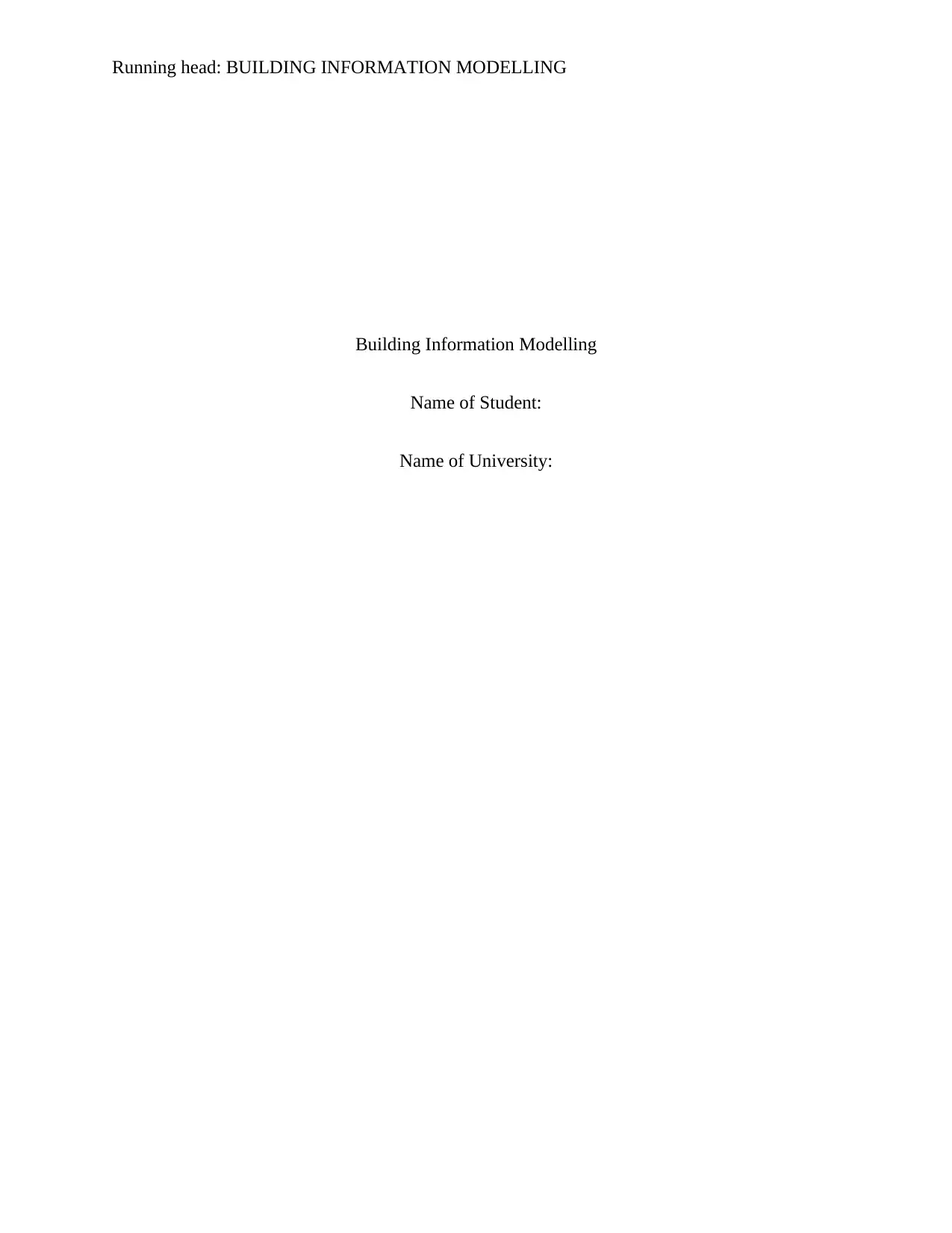
Running head: BUILDING INFORMATION MODELLING
Building Information Modelling
Name of Student:
Name of University:
Building Information Modelling
Name of Student:
Name of University:
Paraphrase This Document
Need a fresh take? Get an instant paraphrase of this document with our AI Paraphraser
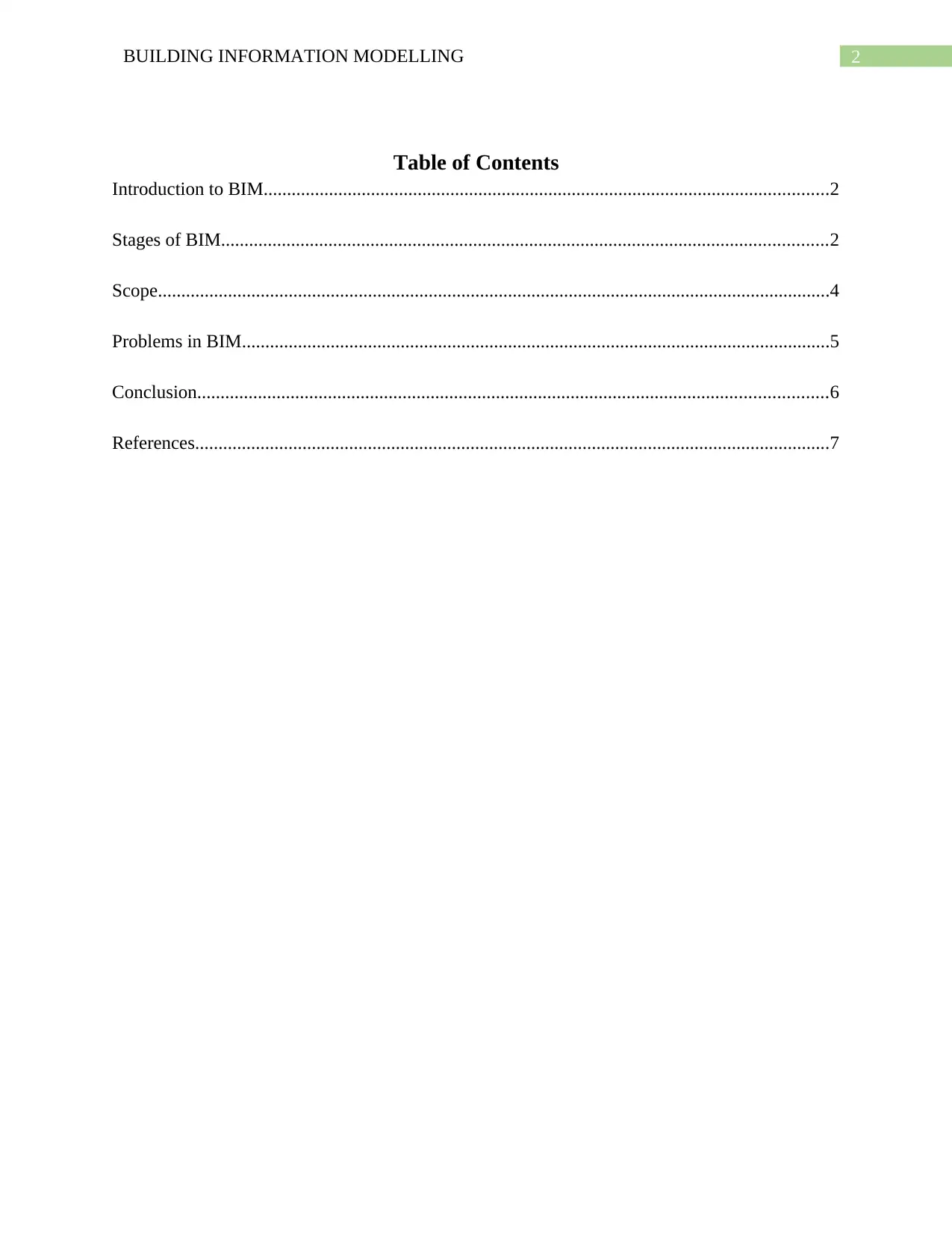
2BUILDING INFORMATION MODELLING
Table of Contents
Introduction to BIM.........................................................................................................................2
Stages of BIM..................................................................................................................................2
Scope................................................................................................................................................4
Problems in BIM..............................................................................................................................5
Conclusion.......................................................................................................................................6
References........................................................................................................................................7
Table of Contents
Introduction to BIM.........................................................................................................................2
Stages of BIM..................................................................................................................................2
Scope................................................................................................................................................4
Problems in BIM..............................................................................................................................5
Conclusion.......................................................................................................................................6
References........................................................................................................................................7
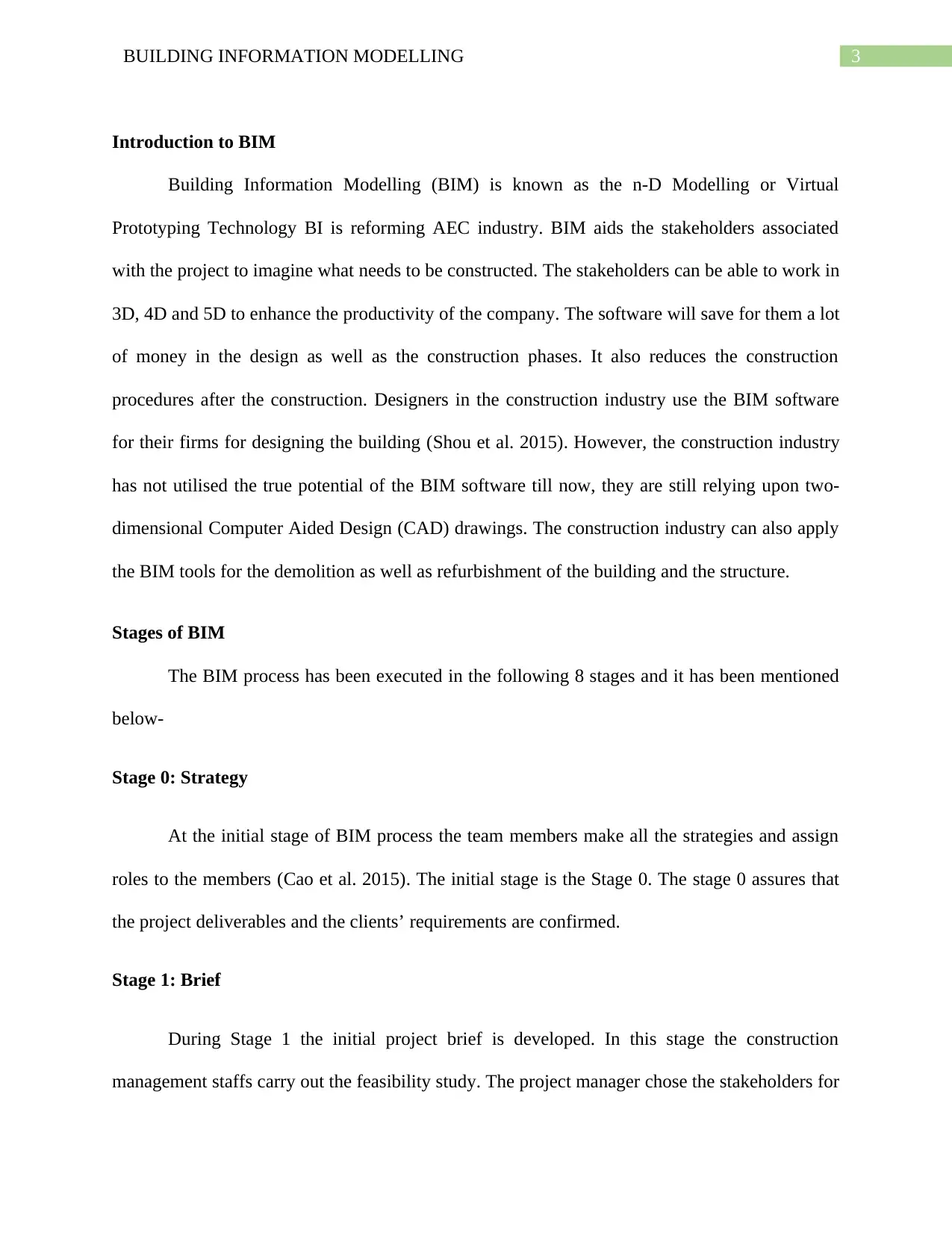
3BUILDING INFORMATION MODELLING
Introduction to BIM
Building Information Modelling (BIM) is known as the n-D Modelling or Virtual
Prototyping Technology BI is reforming AEC industry. BIM aids the stakeholders associated
with the project to imagine what needs to be constructed. The stakeholders can be able to work in
3D, 4D and 5D to enhance the productivity of the company. The software will save for them a lot
of money in the design as well as the construction phases. It also reduces the construction
procedures after the construction. Designers in the construction industry use the BIM software
for their firms for designing the building (Shou et al. 2015). However, the construction industry
has not utilised the true potential of the BIM software till now, they are still relying upon two-
dimensional Computer Aided Design (CAD) drawings. The construction industry can also apply
the BIM tools for the demolition as well as refurbishment of the building and the structure.
Stages of BIM
The BIM process has been executed in the following 8 stages and it has been mentioned
below-
Stage 0: Strategy
At the initial stage of BIM process the team members make all the strategies and assign
roles to the members (Cao et al. 2015). The initial stage is the Stage 0. The stage 0 assures that
the project deliverables and the clients’ requirements are confirmed.
Stage 1: Brief
During Stage 1 the initial project brief is developed. In this stage the construction
management staffs carry out the feasibility study. The project manager chose the stakeholders for
Introduction to BIM
Building Information Modelling (BIM) is known as the n-D Modelling or Virtual
Prototyping Technology BI is reforming AEC industry. BIM aids the stakeholders associated
with the project to imagine what needs to be constructed. The stakeholders can be able to work in
3D, 4D and 5D to enhance the productivity of the company. The software will save for them a lot
of money in the design as well as the construction phases. It also reduces the construction
procedures after the construction. Designers in the construction industry use the BIM software
for their firms for designing the building (Shou et al. 2015). However, the construction industry
has not utilised the true potential of the BIM software till now, they are still relying upon two-
dimensional Computer Aided Design (CAD) drawings. The construction industry can also apply
the BIM tools for the demolition as well as refurbishment of the building and the structure.
Stages of BIM
The BIM process has been executed in the following 8 stages and it has been mentioned
below-
Stage 0: Strategy
At the initial stage of BIM process the team members make all the strategies and assign
roles to the members (Cao et al. 2015). The initial stage is the Stage 0. The stage 0 assures that
the project deliverables and the clients’ requirements are confirmed.
Stage 1: Brief
During Stage 1 the initial project brief is developed. In this stage the construction
management staffs carry out the feasibility study. The project manager chose the stakeholders for
⊘ This is a preview!⊘
Do you want full access?
Subscribe today to unlock all pages.

Trusted by 1+ million students worldwide
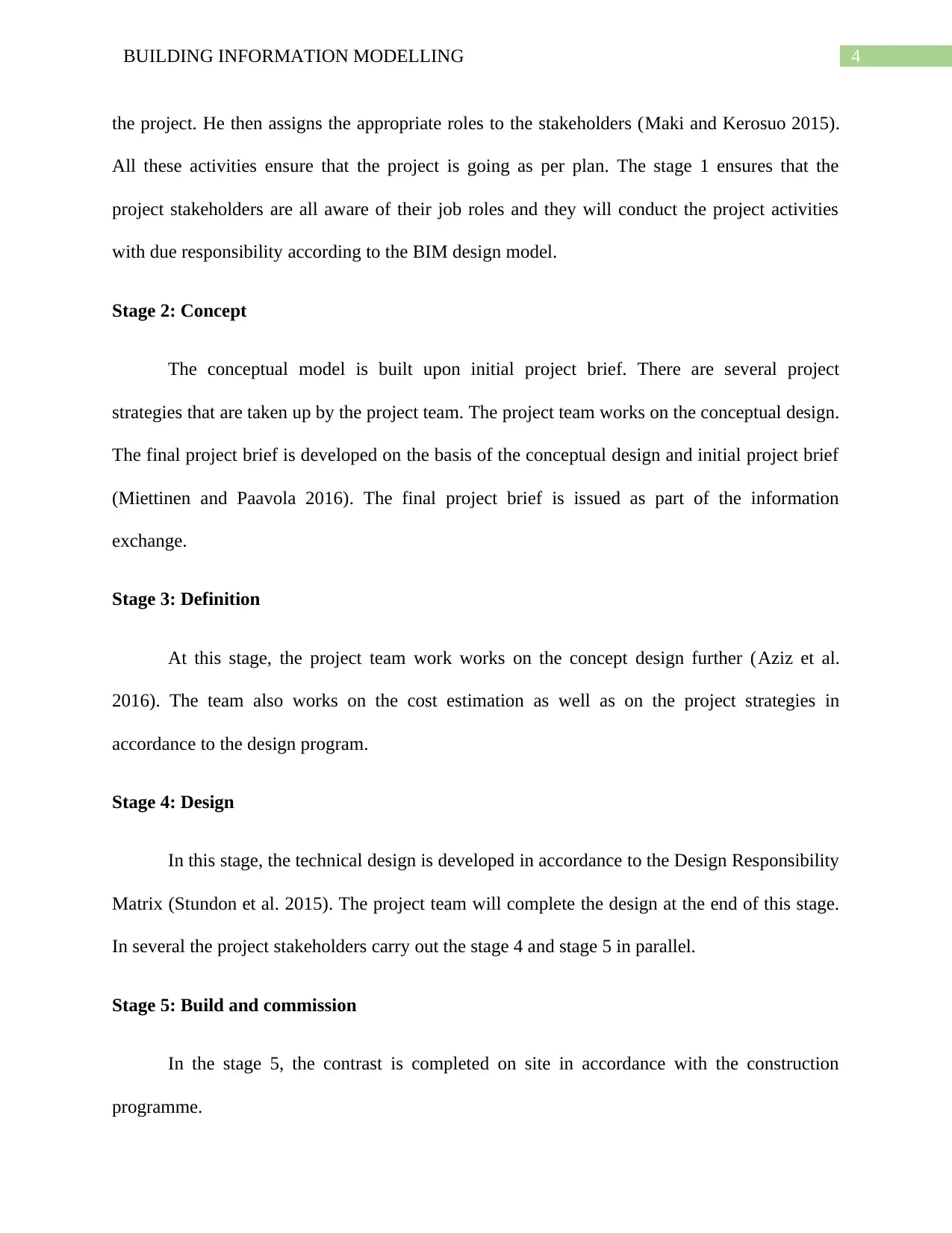
4BUILDING INFORMATION MODELLING
the project. He then assigns the appropriate roles to the stakeholders (Maki and Kerosuo 2015).
All these activities ensure that the project is going as per plan. The stage 1 ensures that the
project stakeholders are all aware of their job roles and they will conduct the project activities
with due responsibility according to the BIM design model.
Stage 2: Concept
The conceptual model is built upon initial project brief. There are several project
strategies that are taken up by the project team. The project team works on the conceptual design.
The final project brief is developed on the basis of the conceptual design and initial project brief
(Miettinen and Paavola 2016). The final project brief is issued as part of the information
exchange.
Stage 3: Definition
At this stage, the project team work works on the concept design further (Aziz et al.
2016). The team also works on the cost estimation as well as on the project strategies in
accordance to the design program.
Stage 4: Design
In this stage, the technical design is developed in accordance to the Design Responsibility
Matrix (Stundon et al. 2015). The project team will complete the design at the end of this stage.
In several the project stakeholders carry out the stage 4 and stage 5 in parallel.
Stage 5: Build and commission
In the stage 5, the contrast is completed on site in accordance with the construction
programme.
the project. He then assigns the appropriate roles to the stakeholders (Maki and Kerosuo 2015).
All these activities ensure that the project is going as per plan. The stage 1 ensures that the
project stakeholders are all aware of their job roles and they will conduct the project activities
with due responsibility according to the BIM design model.
Stage 2: Concept
The conceptual model is built upon initial project brief. There are several project
strategies that are taken up by the project team. The project team works on the conceptual design.
The final project brief is developed on the basis of the conceptual design and initial project brief
(Miettinen and Paavola 2016). The final project brief is issued as part of the information
exchange.
Stage 3: Definition
At this stage, the project team work works on the concept design further (Aziz et al.
2016). The team also works on the cost estimation as well as on the project strategies in
accordance to the design program.
Stage 4: Design
In this stage, the technical design is developed in accordance to the Design Responsibility
Matrix (Stundon et al. 2015). The project team will complete the design at the end of this stage.
In several the project stakeholders carry out the stage 4 and stage 5 in parallel.
Stage 5: Build and commission
In the stage 5, the contrast is completed on site in accordance with the construction
programme.
Paraphrase This Document
Need a fresh take? Get an instant paraphrase of this document with our AI Paraphraser
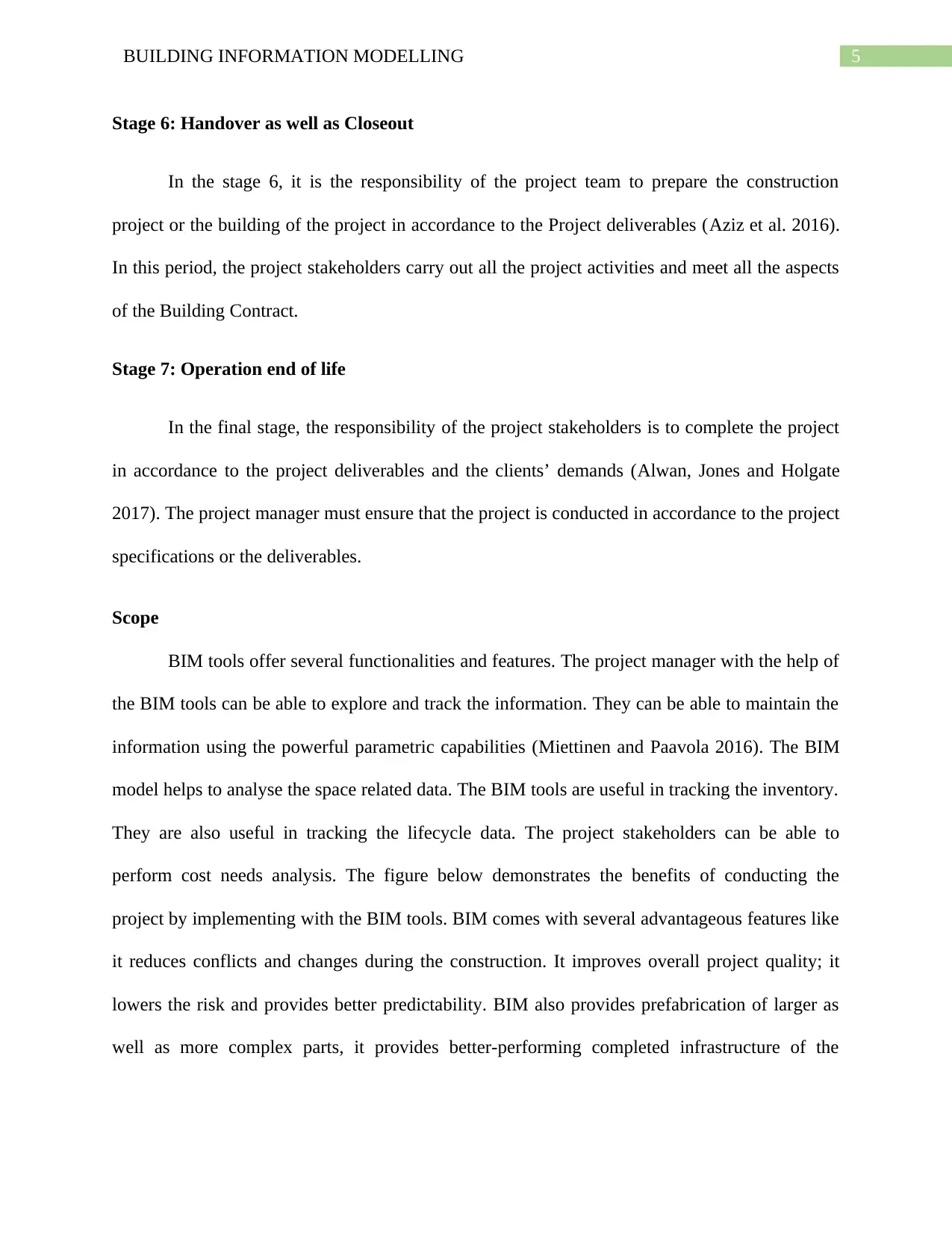
5BUILDING INFORMATION MODELLING
Stage 6: Handover as well as Closeout
In the stage 6, it is the responsibility of the project team to prepare the construction
project or the building of the project in accordance to the Project deliverables (Aziz et al. 2016).
In this period, the project stakeholders carry out all the project activities and meet all the aspects
of the Building Contract.
Stage 7: Operation end of life
In the final stage, the responsibility of the project stakeholders is to complete the project
in accordance to the project deliverables and the clients’ demands (Alwan, Jones and Holgate
2017). The project manager must ensure that the project is conducted in accordance to the project
specifications or the deliverables.
Scope
BIM tools offer several functionalities and features. The project manager with the help of
the BIM tools can be able to explore and track the information. They can be able to maintain the
information using the powerful parametric capabilities (Miettinen and Paavola 2016). The BIM
model helps to analyse the space related data. The BIM tools are useful in tracking the inventory.
They are also useful in tracking the lifecycle data. The project stakeholders can be able to
perform cost needs analysis. The figure below demonstrates the benefits of conducting the
project by implementing with the BIM tools. BIM comes with several advantageous features like
it reduces conflicts and changes during the construction. It improves overall project quality; it
lowers the risk and provides better predictability. BIM also provides prefabrication of larger as
well as more complex parts, it provides better-performing completed infrastructure of the
Stage 6: Handover as well as Closeout
In the stage 6, it is the responsibility of the project team to prepare the construction
project or the building of the project in accordance to the Project deliverables (Aziz et al. 2016).
In this period, the project stakeholders carry out all the project activities and meet all the aspects
of the Building Contract.
Stage 7: Operation end of life
In the final stage, the responsibility of the project stakeholders is to complete the project
in accordance to the project deliverables and the clients’ demands (Alwan, Jones and Holgate
2017). The project manager must ensure that the project is conducted in accordance to the project
specifications or the deliverables.
Scope
BIM tools offer several functionalities and features. The project manager with the help of
the BIM tools can be able to explore and track the information. They can be able to maintain the
information using the powerful parametric capabilities (Miettinen and Paavola 2016). The BIM
model helps to analyse the space related data. The BIM tools are useful in tracking the inventory.
They are also useful in tracking the lifecycle data. The project stakeholders can be able to
perform cost needs analysis. The figure below demonstrates the benefits of conducting the
project by implementing with the BIM tools. BIM comes with several advantageous features like
it reduces conflicts and changes during the construction. It improves overall project quality; it
lowers the risk and provides better predictability. BIM also provides prefabrication of larger as
well as more complex parts, it provides better-performing completed infrastructure of the
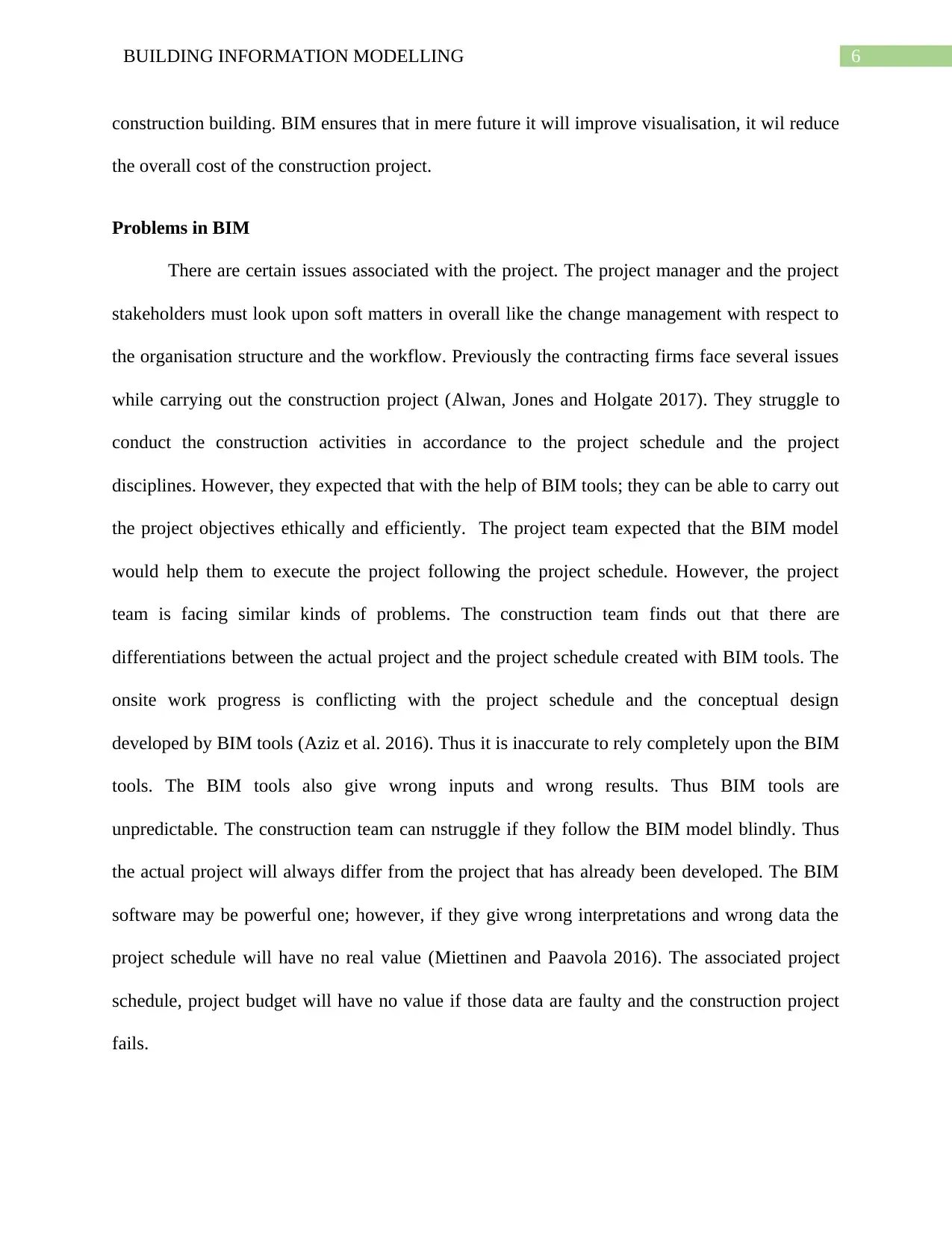
6BUILDING INFORMATION MODELLING
construction building. BIM ensures that in mere future it will improve visualisation, it wil reduce
the overall cost of the construction project.
Problems in BIM
There are certain issues associated with the project. The project manager and the project
stakeholders must look upon soft matters in overall like the change management with respect to
the organisation structure and the workflow. Previously the contracting firms face several issues
while carrying out the construction project (Alwan, Jones and Holgate 2017). They struggle to
conduct the construction activities in accordance to the project schedule and the project
disciplines. However, they expected that with the help of BIM tools; they can be able to carry out
the project objectives ethically and efficiently. The project team expected that the BIM model
would help them to execute the project following the project schedule. However, the project
team is facing similar kinds of problems. The construction team finds out that there are
differentiations between the actual project and the project schedule created with BIM tools. The
onsite work progress is conflicting with the project schedule and the conceptual design
developed by BIM tools (Aziz et al. 2016). Thus it is inaccurate to rely completely upon the BIM
tools. The BIM tools also give wrong inputs and wrong results. Thus BIM tools are
unpredictable. The construction team can nstruggle if they follow the BIM model blindly. Thus
the actual project will always differ from the project that has already been developed. The BIM
software may be powerful one; however, if they give wrong interpretations and wrong data the
project schedule will have no real value (Miettinen and Paavola 2016). The associated project
schedule, project budget will have no value if those data are faulty and the construction project
fails.
construction building. BIM ensures that in mere future it will improve visualisation, it wil reduce
the overall cost of the construction project.
Problems in BIM
There are certain issues associated with the project. The project manager and the project
stakeholders must look upon soft matters in overall like the change management with respect to
the organisation structure and the workflow. Previously the contracting firms face several issues
while carrying out the construction project (Alwan, Jones and Holgate 2017). They struggle to
conduct the construction activities in accordance to the project schedule and the project
disciplines. However, they expected that with the help of BIM tools; they can be able to carry out
the project objectives ethically and efficiently. The project team expected that the BIM model
would help them to execute the project following the project schedule. However, the project
team is facing similar kinds of problems. The construction team finds out that there are
differentiations between the actual project and the project schedule created with BIM tools. The
onsite work progress is conflicting with the project schedule and the conceptual design
developed by BIM tools (Aziz et al. 2016). Thus it is inaccurate to rely completely upon the BIM
tools. The BIM tools also give wrong inputs and wrong results. Thus BIM tools are
unpredictable. The construction team can nstruggle if they follow the BIM model blindly. Thus
the actual project will always differ from the project that has already been developed. The BIM
software may be powerful one; however, if they give wrong interpretations and wrong data the
project schedule will have no real value (Miettinen and Paavola 2016). The associated project
schedule, project budget will have no value if those data are faulty and the construction project
fails.
⊘ This is a preview!⊘
Do you want full access?
Subscribe today to unlock all pages.

Trusted by 1+ million students worldwide
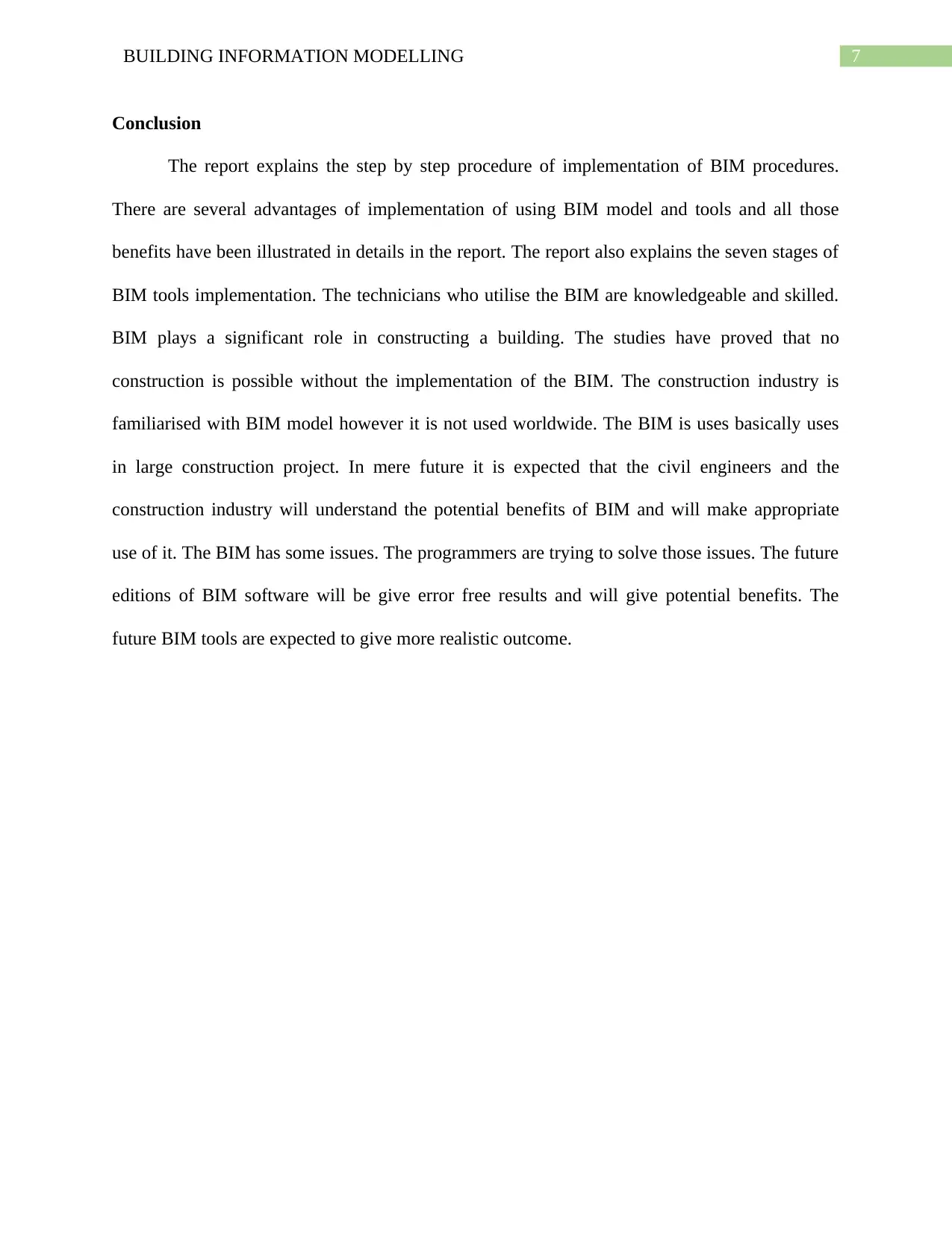
7BUILDING INFORMATION MODELLING
Conclusion
The report explains the step by step procedure of implementation of BIM procedures.
There are several advantages of implementation of using BIM model and tools and all those
benefits have been illustrated in details in the report. The report also explains the seven stages of
BIM tools implementation. The technicians who utilise the BIM are knowledgeable and skilled.
BIM plays a significant role in constructing a building. The studies have proved that no
construction is possible without the implementation of the BIM. The construction industry is
familiarised with BIM model however it is not used worldwide. The BIM is uses basically uses
in large construction project. In mere future it is expected that the civil engineers and the
construction industry will understand the potential benefits of BIM and will make appropriate
use of it. The BIM has some issues. The programmers are trying to solve those issues. The future
editions of BIM software will be give error free results and will give potential benefits. The
future BIM tools are expected to give more realistic outcome.
Conclusion
The report explains the step by step procedure of implementation of BIM procedures.
There are several advantages of implementation of using BIM model and tools and all those
benefits have been illustrated in details in the report. The report also explains the seven stages of
BIM tools implementation. The technicians who utilise the BIM are knowledgeable and skilled.
BIM plays a significant role in constructing a building. The studies have proved that no
construction is possible without the implementation of the BIM. The construction industry is
familiarised with BIM model however it is not used worldwide. The BIM is uses basically uses
in large construction project. In mere future it is expected that the civil engineers and the
construction industry will understand the potential benefits of BIM and will make appropriate
use of it. The BIM has some issues. The programmers are trying to solve those issues. The future
editions of BIM software will be give error free results and will give potential benefits. The
future BIM tools are expected to give more realistic outcome.
Paraphrase This Document
Need a fresh take? Get an instant paraphrase of this document with our AI Paraphraser
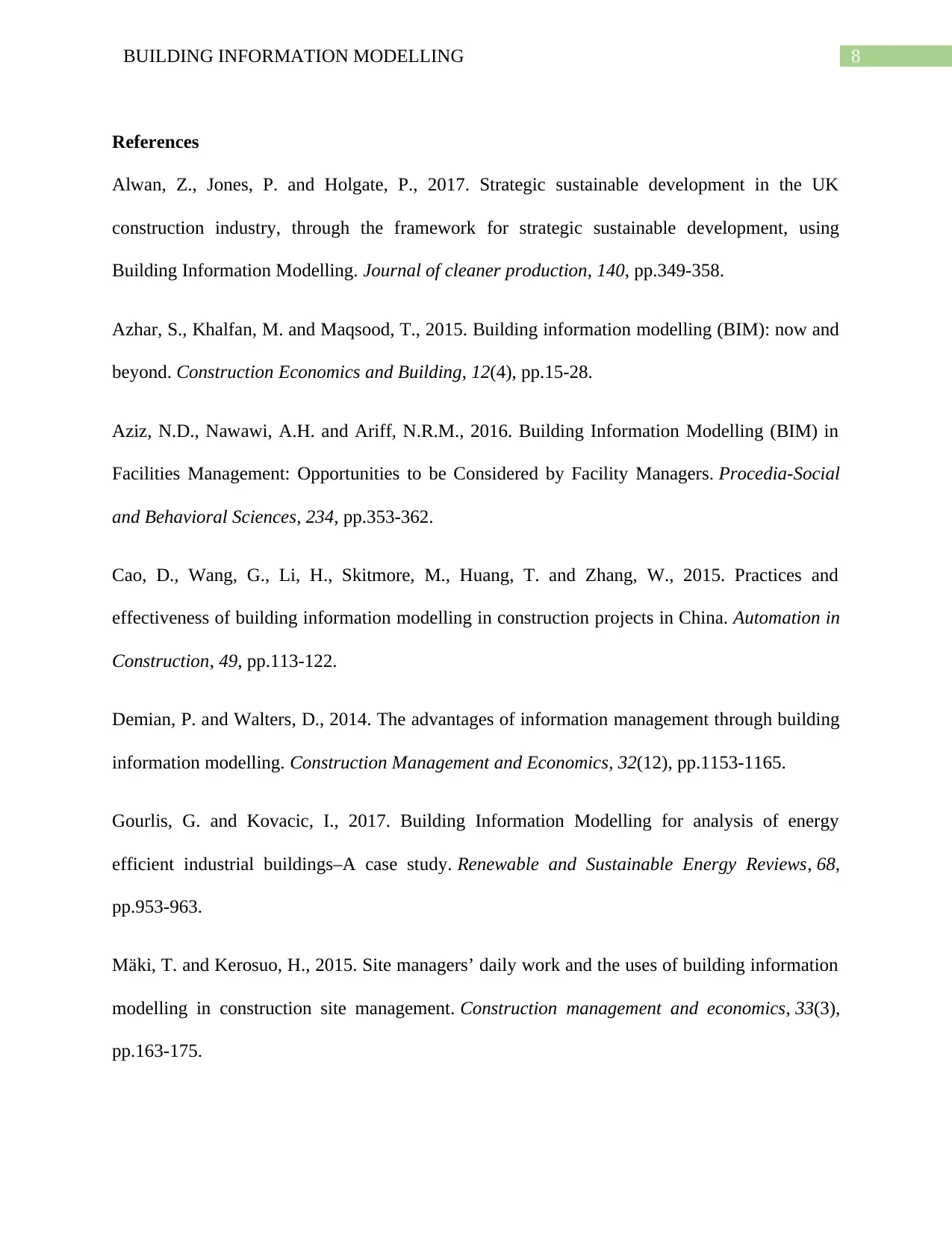
8BUILDING INFORMATION MODELLING
References
Alwan, Z., Jones, P. and Holgate, P., 2017. Strategic sustainable development in the UK
construction industry, through the framework for strategic sustainable development, using
Building Information Modelling. Journal of cleaner production, 140, pp.349-358.
Azhar, S., Khalfan, M. and Maqsood, T., 2015. Building information modelling (BIM): now and
beyond. Construction Economics and Building, 12(4), pp.15-28.
Aziz, N.D., Nawawi, A.H. and Ariff, N.R.M., 2016. Building Information Modelling (BIM) in
Facilities Management: Opportunities to be Considered by Facility Managers. Procedia-Social
and Behavioral Sciences, 234, pp.353-362.
Cao, D., Wang, G., Li, H., Skitmore, M., Huang, T. and Zhang, W., 2015. Practices and
effectiveness of building information modelling in construction projects in China. Automation in
Construction, 49, pp.113-122.
Demian, P. and Walters, D., 2014. The advantages of information management through building
information modelling. Construction Management and Economics, 32(12), pp.1153-1165.
Gourlis, G. and Kovacic, I., 2017. Building Information Modelling for analysis of energy
efficient industrial buildings–A case study. Renewable and Sustainable Energy Reviews, 68,
pp.953-963.
Mäki, T. and Kerosuo, H., 2015. Site managers’ daily work and the uses of building information
modelling in construction site management. Construction management and economics, 33(3),
pp.163-175.
References
Alwan, Z., Jones, P. and Holgate, P., 2017. Strategic sustainable development in the UK
construction industry, through the framework for strategic sustainable development, using
Building Information Modelling. Journal of cleaner production, 140, pp.349-358.
Azhar, S., Khalfan, M. and Maqsood, T., 2015. Building information modelling (BIM): now and
beyond. Construction Economics and Building, 12(4), pp.15-28.
Aziz, N.D., Nawawi, A.H. and Ariff, N.R.M., 2016. Building Information Modelling (BIM) in
Facilities Management: Opportunities to be Considered by Facility Managers. Procedia-Social
and Behavioral Sciences, 234, pp.353-362.
Cao, D., Wang, G., Li, H., Skitmore, M., Huang, T. and Zhang, W., 2015. Practices and
effectiveness of building information modelling in construction projects in China. Automation in
Construction, 49, pp.113-122.
Demian, P. and Walters, D., 2014. The advantages of information management through building
information modelling. Construction Management and Economics, 32(12), pp.1153-1165.
Gourlis, G. and Kovacic, I., 2017. Building Information Modelling for analysis of energy
efficient industrial buildings–A case study. Renewable and Sustainable Energy Reviews, 68,
pp.953-963.
Mäki, T. and Kerosuo, H., 2015. Site managers’ daily work and the uses of building information
modelling in construction site management. Construction management and economics, 33(3),
pp.163-175.
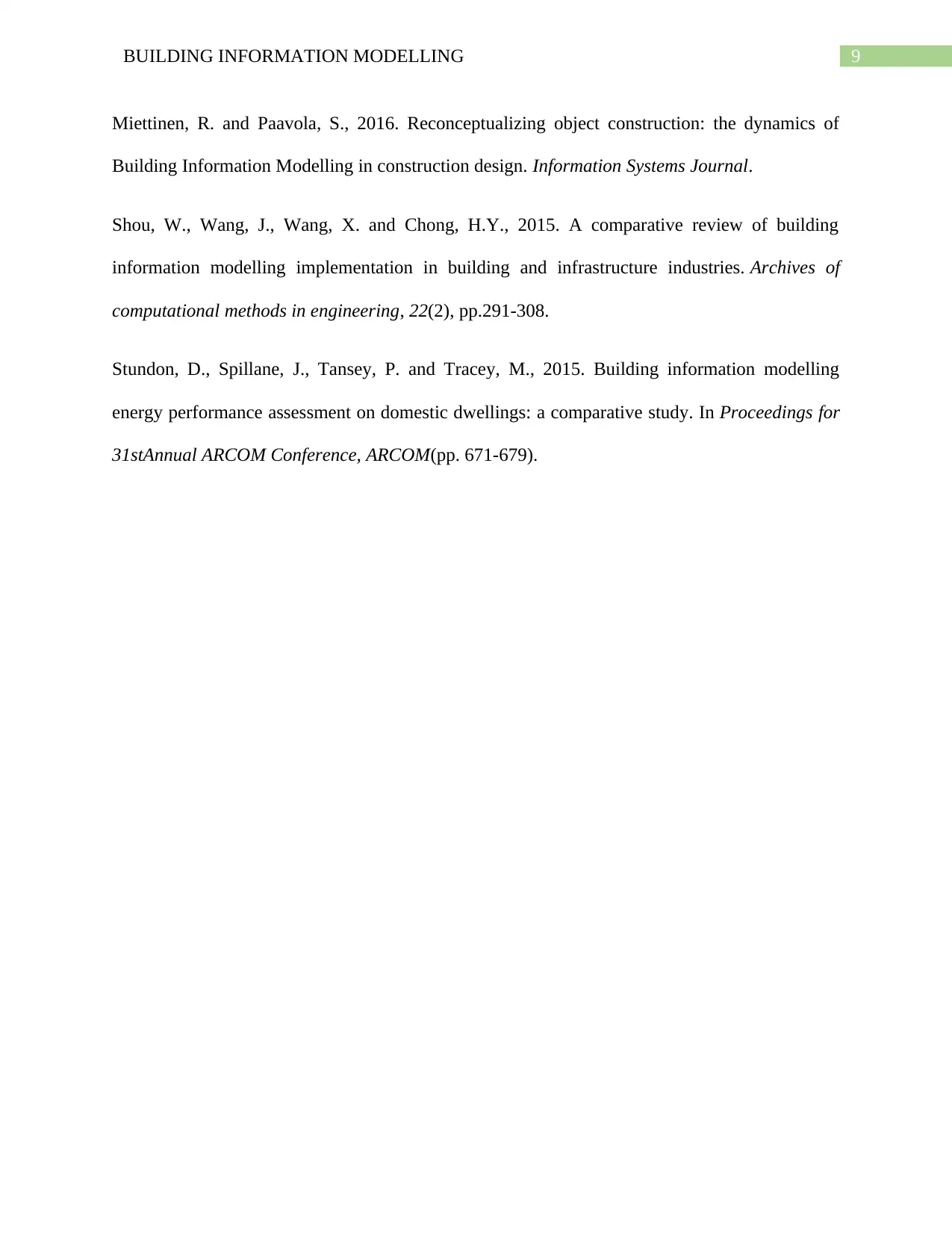
9BUILDING INFORMATION MODELLING
Miettinen, R. and Paavola, S., 2016. Reconceptualizing object construction: the dynamics of
Building Information Modelling in construction design. Information Systems Journal.
Shou, W., Wang, J., Wang, X. and Chong, H.Y., 2015. A comparative review of building
information modelling implementation in building and infrastructure industries. Archives of
computational methods in engineering, 22(2), pp.291-308.
Stundon, D., Spillane, J., Tansey, P. and Tracey, M., 2015. Building information modelling
energy performance assessment on domestic dwellings: a comparative study. In Proceedings for
31stAnnual ARCOM Conference, ARCOM(pp. 671-679).
Miettinen, R. and Paavola, S., 2016. Reconceptualizing object construction: the dynamics of
Building Information Modelling in construction design. Information Systems Journal.
Shou, W., Wang, J., Wang, X. and Chong, H.Y., 2015. A comparative review of building
information modelling implementation in building and infrastructure industries. Archives of
computational methods in engineering, 22(2), pp.291-308.
Stundon, D., Spillane, J., Tansey, P. and Tracey, M., 2015. Building information modelling
energy performance assessment on domestic dwellings: a comparative study. In Proceedings for
31stAnnual ARCOM Conference, ARCOM(pp. 671-679).
⊘ This is a preview!⊘
Do you want full access?
Subscribe today to unlock all pages.

Trusted by 1+ million students worldwide
1 out of 9
Related Documents
Your All-in-One AI-Powered Toolkit for Academic Success.
+13062052269
info@desklib.com
Available 24*7 on WhatsApp / Email
![[object Object]](/_next/static/media/star-bottom.7253800d.svg)
Unlock your academic potential
Copyright © 2020–2025 A2Z Services. All Rights Reserved. Developed and managed by ZUCOL.



